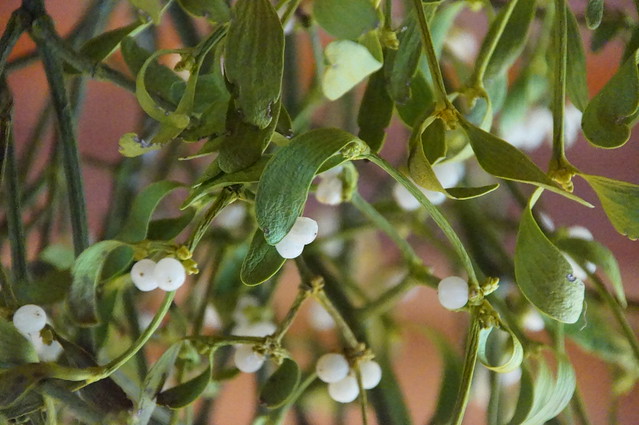
Christmas is about the
birth of Christ
pure and simple.
It is centered around
family, faith, and love.
It is about traditions that help people identify to the birth of Christ.
Holly
“The holly and the ivy,
When they are both full grown,
Of all the trees that are in the wood,
The holly bears the crown.”
-traditional British folk Christmas carol, Roud folk song index No.514
Holly and ivy are two evergreen plants that are traditionally paired in winter folklore. Holly is seen as male, and ivy is seen as female. One winter folklore custom has a boy wearing holly and a girl attired in ivy parade around the village to usher Nature through the dark days and re-emerge next year. In Christian symbolism, the prickly leaves echo Jesus’ crown of thorns and their red berries evoke the blood he shed for humanity’s salvation. In Celtic mythology it’s said that the Holly King rules over the six winter months, and the Oak King rules over the six months of summer.
I Is For Ivy
Winter folklore presents evergreen ivy as the female counterpart to male holly. A number of English Christmas carols dated 1400-1700 feature holly and ivy, and often use them as symbolism for men and women. Since ancient times, evergreens like ivy were brought into the house during the winter months to represent nature’s resurrection in the spring and eternal endurance.
Holming, or Holly-beating
The thankfully extinct old Welsh tradition of holming, or holly-beating, was carried out on the day after Christmas (St Stephens Day). It could refer to the practice of beating the last person out of bed in the morning with holly sprigs. Holming also referred to young men beating the arms or legs of girls with holly until they bled.
Glastonbury ThornThe Glastonbury Holy Thorn is a common hawthorn with a notable difference – it flowers twice a year, first in winter, then in spring. It also bears flowers and berries at the same time. Legend has it that when Joseph of Arimathea came to Britain he visited the spiritual centre of Glastonbury, thrust his staff into the ground at Wearyall Hill, and it grew overnight into a blossoming thorn tree. The ‘original’ thorn was cut down during the English Civil War as a superstitious relic, and it’s said that one of its thorns blinded the wielder of the axe in one eye. Since the 17th century, a flowering branch of the Glastonbury Thorn has traditionally been sent to the reigning queen or king to adorn the table at their Christmas feast.
Holly, Ivy and other greenery such as Mistletoe were originally used in pre-Christian times to help celebrate the Winter Solstice Festival and ward off evil spirits and to celebrate new growth.
Mistletoe is a plant that grows on range of trees including willow, apple and oak trees. The tradition of hanging it in the house supposedly goes back to the times of the ancient Druids; however, there's little evidence that this happened. It is also meant to possess mystical powers which bring good luck to the household and wards off evil spirits. It was also used as a sign of love and friendship in Norse mythology and it features in a story called 'The Death of Baldur'.

When the first Christians came to Western Europe, some tried to ban the use of Mistletoe as a decoration in Churches, because of some of the old stories about it, but many still continued to use it! York Minster Church in the UK used to hold a special Mistletoe Service in the winter, where wrong doers in the city of York could come and be pardoned.
The custom of kissing under Mistletoe seems to comes from England. The earliest recorded date mentioning kissing under the mistletoe is in 1784 in a song from a musical comedy called 'Two to One'. The custom appears to have started around the 1720s, so in the early Georgian period. Mistletoe was also hung on the old English decoration the Christmas Bough or Kissing Bough which were very popular during 1700s - hence the name!
There were illustrations of kissing under the mistletoe in the first book version of 'A Christmas Carol' published in 1843, and this might have helped to popularised the custom. The original custom was that a berry was picked from the sprig of Mistletoe before the person could be kissed and when all the berries had gone, there could be no more kissing!
The name mistletoe comes from two Anglo Saxon words 'Mistel' (which means dung) and 'tan' (which means) twig or stick!
So you could translate Mistletoe as 'poo on a stick'!!! Not exactly romantic is it!
The UK and Germany were the main countries to keep the use of the greenery as decorations. Here are the Christian meanings:

The prickly leaves represent the crown of thorns that Jesus wore when he was crucified. The berries are the drops of blood that were shed by Jesus because of the thorns.
In Scandinavia it is known as the Christ Thorn.
In pre-Christian/pagan times, Holly was thought to be a male plant and Ivy a female plant. An old tradition from the Midlands of England says that whatever one was brought into the house first over winter, tells you whether the man or woman of the house would rule that year! But it was unlucky to bring either into a house before Christmas Eve.

Ivy has to cling to something to support itself as it grows. This reminds us that we need to cling to God for support in our lives.
In Germany, it is traditional that Ivy is only used outside and a piece tied to the outside of a Church was supposed to protect it from lightning!

Laurel has been worn as a wreath on the head to symbolise success and victory for thousands of years.
It symbolises the victory of God over the Devil.

Fir and Yew trees are evergreen and so signify everlasting life with God.
Fir is also very commonly used for Christmas Trees.

Rosemary was connected with the Virgin Mary (because it was thought to be Mary's favorite plant) and people thought that it could protect you from evil spirits. It is also sometimes called the friendship plant and it was the most common garnish put on the boar's head that rich people ate at the main Christmas meal in the Middle ages!
It is also known as the remembrance herb and was used at Christmas as this is the time that we remember the birth of Jesus.
In the late 1700s a special Christmas Rosemary Service was started in Ripon Cathedral School where a red apple, with a sprig of Rosemary in the top of it, was sold by the school boys to the members of the congregation for 2p, 4p or 6p (depending on the size of apple!).

Hanging a circular wreath of evergreens during mid winter seems to go back a very long way. It might have started back in Roman times when wreaths were hung on their doors as a sign of victory and of their status. Rich Roman women also wore them as headdresses at special occasions like weddings and to show they were posh. Roman Emperors also wore Laurel Wreaths. They were also given to the winners of events in the original Olympic Games in Greece.
The word 'wreath' comes from the Old English word 'writhen' which means to writhe or twist. Christmas Wreaths as we know them today, might have started life as Kissing Boughs (see below) or come from the German and Eastern European custom of Advent Wreaths.
In the UK, before Christmas Trees became popular and dating back to the Georgian period, and possibly earlier; another popular form of Christmas/mid winter decoration was the Kissing Bough or Bunch. These were made of five wooden hoops that made the shape of a ball (four hoops vertical to form the ball and then the fifth horizontal to go around the middle). The hoops were covered with Holly, Ivy, Rosemary, Bay, Fir or other evergreen plants. Inside the hoops were hung red apples (often hung from red ribbons) and a candle was either put inside the ball at the bottom or round the horizontal hoop. The bough was finished by hanging a large bunch of mistletoe from the bottom of the ball. (For a simpler bough you could also just have a horizontal hoop decorated and hung with apples and the mistletoe.)
It is traditional to take down the decorations after Twelfth Night (5th January) on Epiphany (January 6th). But during the middle ages, greenery (including Mistletoe) was often left hanging up until Candlemas (when Christians celebrate Jesus going to the Jewish Temple as a baby) in early February!